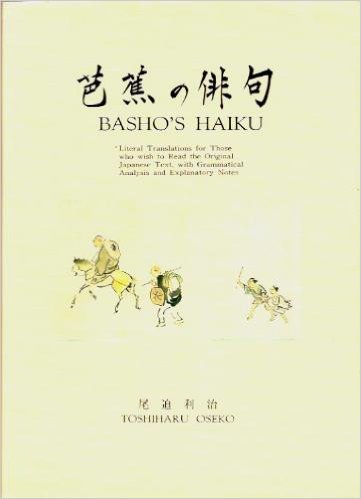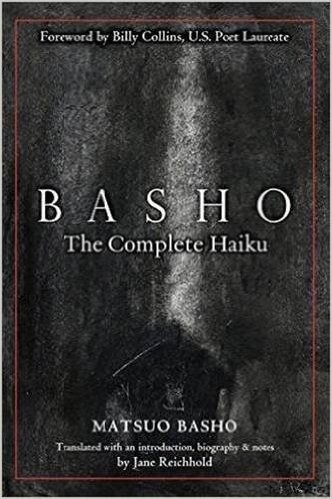A haiku is just a tiny poem, the size of your breath. They are good for you.
- History.
The Haiku originated in Japan.
Historically, it derives from the haikai (a linked-verse poem) which was created
by a group of poets as a long series of small stanzas (or links).
The first stanza, which was called the hokku ("starting verse"),
set the tone for the subsequent poem.
Usually it set the scene by including a reference to the location and season.
Often the most honored poet of the group was invited to compose the hokku.
Poets would practice writing hokku, many of which were never used as opening links.
The creation of the Haiku as a form in its own right occurred in the seventeenth century,
when feudalism was weakening in Japan while merchants and trade were strengthening.
The term haiku arose in the 1890's, largely through Masaoka Shiki.
The haiku retained the "5-7-5" form
of the hokku,
and retained its inclusion of a reference to the season.
In Japan intense study is made of what are acceptable
kigo (season words)
and kidai (seasonal topics).
Some English-language poets incorporate translated
kigo (such as "snow") and some create new ones (such as "Christmas").
In
Japanese Haiku,
Kenneth Yashuda asserts that a haiku is a poem that:
- Arises from "the haiku attitude [which] is a
readiness for an experience for its own sake."
- Expresses "a haiku moment" whose
"quality is eternal, for in this state, man and his environment are one unified whole,
in which there is no sense of time."
- Examples.
Among the most beautiful and powerful haiku are those written by the Japanese poets
- Matsuo Bashō (1644-94), the ascetic and seeker,
- Yosa Buson (1716-83), the artist, and
- Kobayashi Issa (1763-1827), the humanist.
Some of the best translations of their work are in
The Essential Haiku: Versions of Bashō, Buson, and Issa,
edited by Robert Hass.
The author of this essay is delighted to report that some of her
haiku have been
voted "Best of Issue" by readers of the
haiku magazine Geppo.
-
Form.
There is great variation and discussion within Japan on
"how to write a haiku"
and even more argument outside of Japan on how to write non-Japanese haiku.
I advise you to try each feature of the haiku form,
in order to learn from the inside what those attributes help you bring to your poems.
Those interested in 65 different "rules" for haiku
can search the web for Jane Reichhold's essay Haiku Rules that have Come and Gone.
As Reichhold comments:
"Haiku, which seem so light, free and spontaneous, are built on discipline.
... Bashō had his motto: 'Learn the rules; and then forget them.'
... here are some old and new rules."
Reichhold suggests that you decide on some rules from essays and haiku and other poems you admire.
And that after you have used those for a while, and become skilled with them,
you pick and explore other rules.
Here is a small set of rules to start with:
- Write the poem short, perhaps short enough that it can be said in a breath.
- Write the poem in three lines, with the second line slightly longer than the first and last.
-
Divide the haiku into two parts,
using a syntactical break to divide the poem after the first or second line. This can be done by grammar
or by punctuation.
In Japanese, appropriate punctuation is a
kireji ("cutting word") which is a sounded word,
such as if we said "semi-colon".
- If the "traditional" syllable count is used for the haiku,
use this form:
5 syllables
7 syllables
5 syllables
|
Writers in the USA often use fewer syllables in their haiku, either from
personal preference or from a belief that this approximates better the time taken to speak
such lines in Japanese, giving a form such as:
3 syllables
5 syllables
3 syllables
|
-
In English it may be useful to count stresses rather
than syllables, such as:
2 stresses
3 stresses
2 stresses
|
-
Create internal "links" between lines by:
- Association, where something in the one line shares something (perhaps
in appearance, or in use, or in situation) with something in the line it follows.
For example, North Americans associate pumpkin pie with Thanksgiving.
- Contrast, where something in the new link (e.g., quickness, darkness, arrival)
is in opposition to something in the link it follows
(e.g., sloth, brightness, departure).
- Comparison, which (like the European use of simile and metaphor)
causes one thing to bring another subject to mind.
Write two different images that are in some way
similar and that complete each other.
- Your Composition.
Haiku is not just the
form; it is a way of experiencing in the world around us.
Here are some steps to take in creating a Haiku:
- Look around you, where you are.
Write phrases of what you see.
The phrases don't need to be connected.
Make at least one phrase for each sense.
Write some more phrases, each with some words that reflect location. E.g.,
"on a withered branch."
Then write some more phrases, reflecting the season or the time of year. E.g.,
"oak leaves budding."
- Some haiku doctrines require that you
"compose on the spot," writing the haiku when and where you experience it.
Some poets claim that this is the only way
for a haiku to have true and fresh originality.
Other poets "compose from recollection" hours, days, or years later.
Some poets claim that this deepens the associations in the haiku, though letting
your subconscious and conscious mind mull over the images.
And other poets "compose from imagination."
Some poets believe that the greatest creativity is shown in this method,
provided that the result "feels" honest.
We suggest that you try each method.
- As with all formal poems nowadays, it is vital that the form does not "drive" your poem.
If the form begins to feel forced, then
the poem's content must be asserted.
- Traditionally, you only break the form's rules because you choose to,
not because you lack the skills and devotion to make
your poem work in the traditional form.
-
Some favorite construction techniques for haiku:
- Ambiguity; double meaning.
- Association.
- Comparison.
- Contrast.
- Divine in the common.
- Focus narrowing.
- Humor.
- Linkage: close.
- Linkage: leaping.
- Metaphor.
- Paradox.
- Pun.
- Riddle.
- Sabi (loneliness, solitude, beauty).
- Shasei (nature sketch) or
shajutsu (reality).
- Simile.
- Synesthesia (sense switching).
- Wabi (beauty of the worn, aged, and simple).
- Yûgen (mystery and sacredness of the ordinary).
- A Linguist's Comments on Sounds and Syllables in Haiku.
The following notes are taken from an e-mail to me by linguist
Katsuhiko Momoi:
Some thoughts from a linguistic point of view.
1. "Onji" or "Jion" are simply inaccurate terms to use to refer to
countable units in Haiku or Tanka poetry. Someone must have incorrectly
used these for that purpose at one point in history and somehow they
"stuck". This type of incorrect identification and usage is fairly
common in the annals of lexicography.
2. Though there is still some controversy, it is more or less accepted
that Japanese have both syllable and mora. A syllable is a unit that
can bear a Japanese pitch accent or forms a coherent physical
phonetically pronounceable entity. A syllable can be long or short.
Mora(e) are used in "counting" in poetry and other language-related
tasks. Long syllables are counted as 2 morae and short ones as 1 mora.
3. Haiku and Tanka generally use mora (or a counting unit) as the basis
for determining 5-7-5(-7-7) lengths.
4. Here are possible syllable types in Japanese:
(C)V
(C)VV
(C)VN
(C)VC-
where C = consonant, V = vowel, N = a mora nasal, i.e. "n". There could
be also (G = glide, i.e. "y" or "w") after C and before V.
The first type above is counted as 1 mora unit and the other 3 are
counted as 2 mora units for a variety of counting purposes in Japanese
including that in poetry.
|
- Senryū
-
Humorous haiku
are now called
senryū,
to distinguish these jokey little poems, often targeting their mirth on someone else,
from the more austere and inward
haiku.
Some western groups differentiate them strongly, while others (in acknowledgment of their sometimes fuzzy boundary)
do not; the premier USA journals
Modern Haiku
and
The Heron's Nest
do not currently differentiate.
See our blog for
Haiku Humor: Wit and Folly in Japanese Poems and Prints
(by Stephen Addiss with Fumiko and Akira Yamamoto),
a particularly delightful
senryū collection.
- A Last Word.
Just because you start with the intention of writing a Haiku, you do not have to
keep your poem in that form if it does not work for you.
Your attempt to write a haiku
may help you find words that you would not have found otherwise.
And you may decide that you choose to end up with a
poem in a different form.
- Other Books on Haiku.

|
The Essential Haiku: Versions of Bashō, Buson, and Issa
edited by Robert Hass.
Enthralling essays by the past-poet laureate of the U.S.A. of
the lives of three masters and inventors
of the haiku tradition in Japan:
Matsuo Bashō,
Yosa Buson, and
Kobayashi Issa.
|

|
Haiku World: An International Poetry Almanac
by William J. Higginson, Meagan Calogeras (Editor)
Over 1000 poems by more than 600 poets living in 50 countries
and writing in 25 languages, presented in both English and their original languages.
The tradition begun hundreds of years ago in Japan is now clearly international.
See the companion volume, The Haiku Seasons, for the tradition of the haiku genre
(particularly haiku, senryu, and linked poetry).
|

|
The Japanese Haiku: Its Essential Nature, History, and Possibilities in English, With Selected Examples,
by Kenneth Yasuda.
History of the haiku as it developed into a universal and adaptable poetic structure.
|

|
An Introduction to Haiku: An Anthology of Poems and Poets from Bashō to Shiki
by Harold Gould Henderson (Editor).
Analyzes the development of Japanese haiku under the leadership of Bashō, Buson, Issa, and Shiki.
Includes the "Romaji" (or Romanized)
transliteration of the Japanese, showing the original sounds of the poem.
Henderson rhymes the first and last lines (sometimes awkwardly);
his translations are mainly 5-7-5 English syllables (giving a heavy poem compare to the
language of the Japanese).
|
 Modern Haiku.
Modern Haiku.
 The Heron's Nest.
The Heron's Nest.
 Roadrunner e-magazine.
Roadrunner e-magazine.
 Index of Poetry.
Index of Poetry.
 Highlights for Poetry.
Highlights for Poetry.
 Books of Poetry Form.
Books of Poetry Form.
 How to Write Poetry.
How to Write Poetry.
 Latest books read.
Latest books read.
 Haibun.
Haibun.
 Haiga.
Haiga.
 Haiku.
Haiku.
 Hay(na)ku.
Hay(na)ku.
 Rengay.
Rengay.
 Renku.
Renku.
 Tanka.
Tanka.
 Tan-renga.
Tan-renga.
 Concrete.
Concrete.
 Fib.
Fib.
 Ghazal.
Ghazal.
 Lai.
Lai.
 Pantoum.
Pantoum.
 Prose poem.
Prose poem.
 Rondeau.
Rondeau.
 Rubáiyát.
Rubáiyát.
 Sestina.
Sestina.
 Skaldic verse.
Skaldic verse.
 Sonnet.
Sonnet.
 Terza rima.
Terza rima.
 Triolet.
Triolet.
 Tritina.
Tritina.
 Villanelle.
Villanelle.
 Yuki Teikei Haiku Society:
Yuki Teikei Haiku Society:
 Join.
Join.
 GEPPO magazine
and
Haijin commented in GEPPO.
GEPPO magazine
and
Haijin commented in GEPPO.
 Annual anthologies.
Annual anthologies.
 2007.
2007.
 2008
(a haibun).
2008
(a haibun).
 Toward an Aesthetic for English-Language Haiku by Lee Gurga.
Toward an Aesthetic for English-Language Haiku by Lee Gurga.
 2004 Pescadero Haiku Weekend Workshop (including exercises) with Christopher Herold.
2004 Pescadero Haiku Weekend Workshop (including exercises) with Christopher Herold.
 El Poema Concreto.
El Poema Concreto.
 Bashō.
Bashō.
 J. Zimmerman.
J. Zimmerman.
 J. Zimmerman (haiku).
J. Zimmerman (haiku).
 J. Zimmerman (tanka).
J. Zimmerman (tanka).
 Jane Hirshfield.
Jane Hirshfield.
 Marianna Monaco.
Marianna Monaco.
 Patricia J. Machmiller.
Patricia J. Machmiller.
 Shiki (haiku).
Shiki (haiku).








